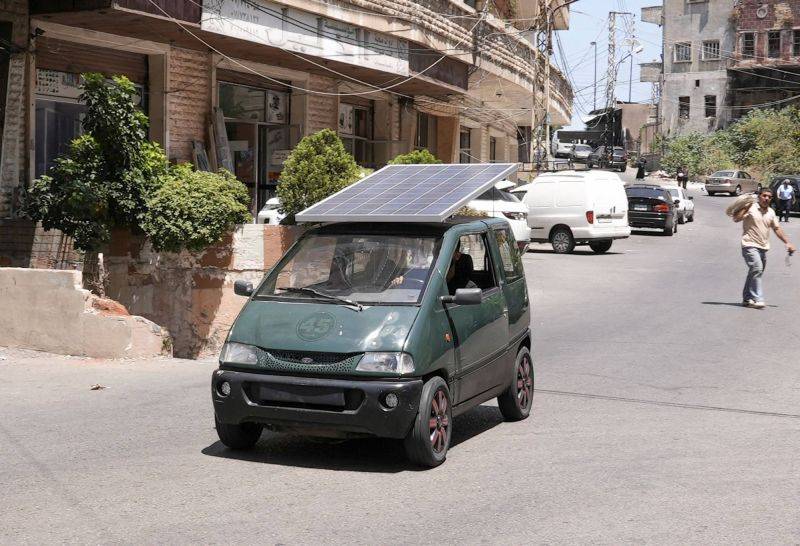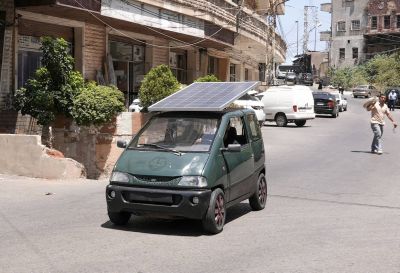
Ahmad Safadi at the wheel of his solar car, in Saida, June 23. (Credit: Issam Abdullah/Reuters)
Amid the electricity crisis hitting the Lebanese, solar panels have become increasingly present on the roofs of buildings. Seeing one on the roof of a car is quite exceptional.
These photovoltaic panels, over a meter long, ensure that Safadi, 31, cuts a swathe through the streets of Saida. His self-installed innovation looks all the more futuristic in a country seemingly regressing.
“In June, I equipped my electric car with a system to recharge the batteries with solar energy,” he told L’Orient-Le Jour. Ten years ago, his “Erad” — a second-hand French-made microcar that he had just bought — was still running on gasoline.
In 2013 he came up with the idea of turning it into an electric vehicle, to save on fuel costs, for “environmental reasons,” and mainly out of his “passion for machinery.”
“I’ve always loved to tinker,” he said, noting that he disassembled the original parts of his car, “starting with the engine, the gas tank, the exhaust pipe, the cooling fan ...”
“I replaced them with an electric engine and six batteries,” he added. The conversion took in a few months, because he only worked on it a few hours per week.
Saying that Safadi was clairvoyant is an understatement. When other motorists faced a fuel shortage last summer, losing their minds in endless gas station queues, he was driving his small car that could be recharged with an electric plug connected to a generator.
Then the cost of the subscription to the neighborhood generator began to rise at an insane rate.
“The bills reached historic heights,” he said, “especially since in Saida the state was supplying one hour of electricity per week or every ten days.”
Faced with the prohibitive prices, resorting to green energy came to mind.
“The photovoltaic cells [solar panel] produce the current that is stored in the batteries,”he explained to L’Orient-Le Jour, “which in turn put the vehicle in motion.”
Commenting on how far the car can travel before the battery needs recharging, the young man said it is “sufficient,” especially since he hardly leaves his city. “On flat ground, I can drive for about 80 kilometers,” he said, “but driving uphill, the batteries run down faster.”
Fame
To fully recharge the batteries, it takes four hours when the vehicle is stationary, more when it is in motion. In summer, Safadi said, “the strong sunlight favors a quick storage of energy, while in winter, its absorption depends on sunlight, the temperature and the presence of clouds.”
In Lebanon it is very sunny, almost all year long. It is so sunny that Safadi can use the solar panels installed on his car to light his bicycle repair shop and run the fridge there. While the panels cost him $500, it seems that he recovered the expense in a short time.
One question remains: do the authorities allow such innovation? He said that he doesn’t know. “In any case,” he added, “the police did not stop me. As I pass, they greet me and say with a smile, [saying,] ‘you have become famous!’”
Safadi’s initiative has both personal and environmental benefits, even if it is not easy to implement, he said. Saving fuel and electricity costs, no emission of harmful gasses and particles … So many elements to consider to save money and to take part in sustainable development.
Car manufacturers and start-ups around the world are beginning to follow this trend. They are marketing — even in a timid way — vehicle-integrated PV.
This story was originally published in French in L'Orient-Le Jour, translated by Joelle El Khoury.
